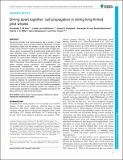Diving apart together : call propagation in diving long-finned pilot whales
Abstract
Group-living animals must communicate to stay in contact. In long-finned pilot whales, there is a trade-off between the benefits of foraging individually at depth and the formation of tight social groups at the surface. Using theoretical modelling and empirical data of tagged pairs within a group, we examined the potential of pilot whale social calls to reach dispersed group members during foraging periods. Both theoretical predictions and empirical data of tag pairs showed a potential for communication between diving and non-diving group members over separation distances up to 385 m (empirical) and 1800 m (theoretical). These distances match or exceed pilot whale dive depths recorded across populations. Call characteristics and environmental characteristics were analysed to investigate determinants of call detectability. Longer calls with a higher sound pressure level (SPL) that were received in a quieter environment were more often detected than their shorter, lower SPL counterparts within a noisier environment. In a noisier environment, calls were louder and had a lower peak frequency, indicating mechanisms for coping with varying conditions. However, the vulnerability of pilot whales to anthropogenic noise is still of concern as the ability to cope with increasing background noise may be limited. Our study shows that combining propagation modelling and actual tag recordings provides new insights into the communicative potential for social calls in orientation and reunion with group members for deep-diving pilot whales.
Citation
Kok , A C M , van Kolfshoten , L , Campbell , J A , von Benda-Beckmann , A M , Miller , P J O , Slabbekoorn , H & Visser , F 2020 , ' Diving apart together : call propagation in diving long-finned pilot whales ' , Journal of Experimental Biology , vol. 223 , no. 10 , jeb207878 . https://doi.org/10.1242/jeb.207878
Publication
Journal of Experimental Biology
Status
Peer reviewed
ISSN
0022-0949Type
Journal article
Description
This research was funded by Office of Naval Research awards [N00014-08-1-0984, N00014-10-1-0355, N00014-15-1-2341], the Dutch Royal Navy (Koninklijke Nederlandse Marine) and the Norwegian Navy (Forsvarets Forskningsinstitutt – FFI).Collections
Items in the St Andrews Research Repository are protected by copyright, with all rights reserved, unless otherwise indicated.

